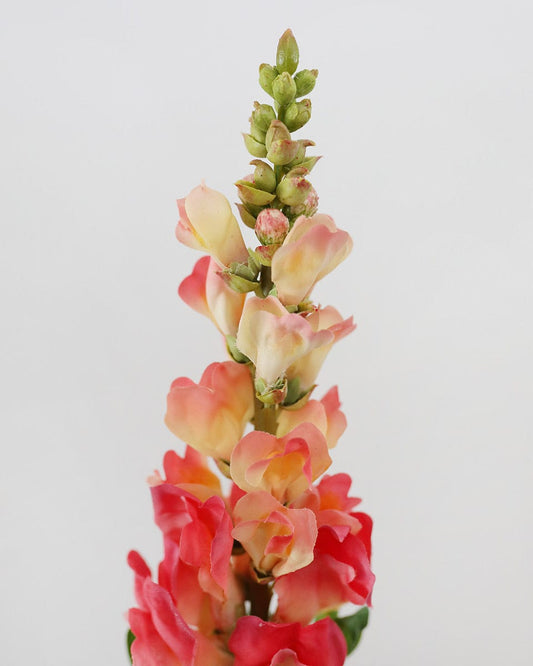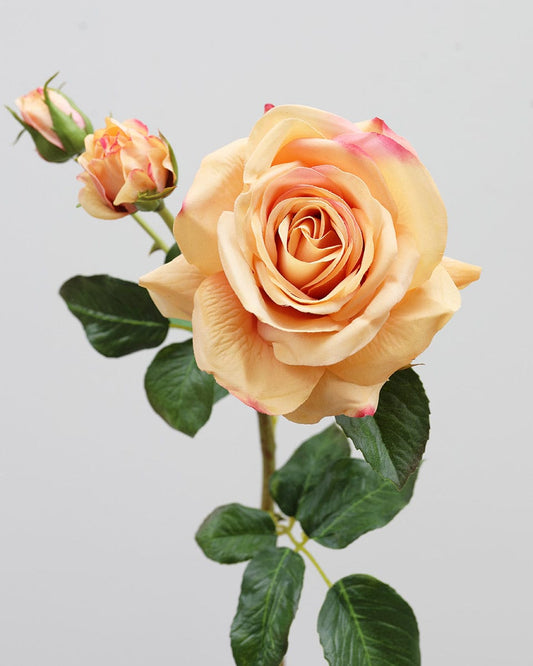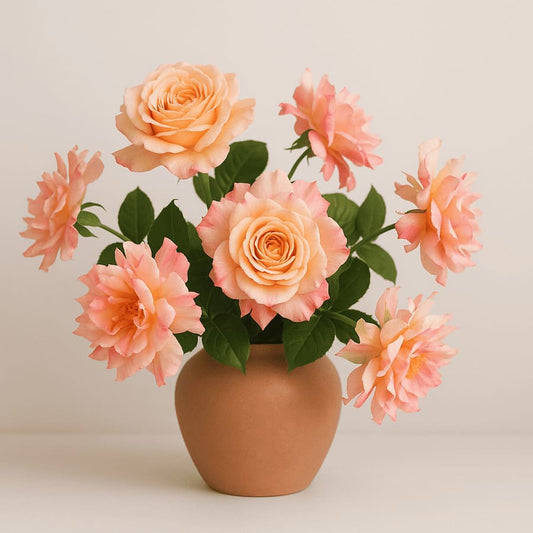The Art of Arranging Real Touch Flowers in 2025

Something magical happened yesterday while adjusting the light in my workshop. The afternoon sun caught one of my Real Touch roses at exactly the right angle—17 degrees, if I'm being precise—and for a split second, I genuinely questioned whether it was artificial. After eighteen years in this field, that moment of doubt still thrills me. It reminds me why the art of arranging real touch flowers has evolved so dramatically, especially as we move through 2025.
Through my collaboration with Prestige Botanicals on their Real Touch technology development, I've watched this craft transform from simple silk arrangements to what I can only describe as botanical wizardry. The techniques I'm seeing now—particularly the variable-density construction methods and cytology-inspired texturing—have completely revolutionized how we approach artificial flower arrangements.
Key Takeaways
- Real Touch technology now mimics natural cellular structures for unprecedented realism
- Strategic layering creates depth that rivals fresh flower arrangements
- Color temperature awareness transforms how arrangements appear throughout the day
- Texture variation within single varieties adds authentic botanical complexity
- Investment in quality Real Touch pieces delivers decades of beauty
Understanding the Science Behind Modern Real Touch Technology
Ever wonder why some artificial flowers make you do a double-take while others scream "craft store"? The answer lies in something called cytology-inspired texturing—a technique I helped develop during my three-month petal count study. Real Touch flowers now incorporate microscopic surface variations that mirror how light interacts with living plant cells.
The breakthrough came when we realized that fresh petals aren't uniformly smooth. Under magnification, they reveal tiny ridges, valleys, and translucent areas that create subtle light diffusion. Modern Real Touch manufacturing replicates these cellular patterns, which is why you'll find yourself questioning reality when you run your fingers across these petals.
What sets 2025's arrangements apart is our understanding of how different flower types exhibit unique cellular signatures. This scientific approach means each variety now feels distinctively authentic rather than generically "silky."
Yesterday I noticed something new about this particular piece that perfectly demonstrates this cellular mimicry.


Real Touch Prestige Soft Yellow Rose 22"
The cellular structure of these petals reveals why Real Touch technology works so brilliantly. Each surface variation catches light differently, creating that authentic depth you'd expect from garden roses. The soft yellow tone—somewhere between butter and cream, though I'm still debating the exact classification—demonstrates how color saturation varies naturally across real petals.
The texture variation within this single bloom showcases three distinct petal zones, each with different cellular patterns that mirror how moisture affects petal development in living roses.
Mastering Strategic Layering for Dimensional Depth
Right, so here's where most people miss the mark completely. They place flowers like they're arranging a bouquet of identical stems, but authentic arrangements require understanding botanical hierarchy. In nature, flowers don't grow in perfect symmetry—they compete for light, creating natural layers and unexpected angles.
My approach starts with what I call the "failure garden" principle, named after my early attempts that looked like botanical disasters. Each arrangement needs primary, secondary, and tertiary focal points, positioned at varying heights and depths. The primary blooms establish the visual foundation.
Secondary elements fill gaps while adding textural contrast. This is where I get genuinely excited about mixing flower types. Understanding these relationships transforms flat arrangements into three-dimensional landscapes that rival seasonal flower arrangements. Between you and me, I still struggle with this sometimes when working with particularly bold pieces.


Real Touch Green Hydrangea 28.5"
This commanding height makes it perfect for establishing vertical structure in arrangements. The clustered petal formation creates visual density that contrasts beautifully with single-bloom flowers. Notice how the green tones shift from sage to forest depending on lighting—that's the Real Touch surface technology responding to environmental conditions exactly like living hydrangeas.
 Pro Tip: The Triangle Foundation Method
Pro Tip: The Triangle Foundation Method
The key insight here is that depth comes from interruption, not perfection. Your eye needs obstacles and surprises to create the illusion of natural growth patterns. This understanding of layering principles applies whether you're creating modern home decor or traditional arrangements.
Color Temperature Mastery for All-Day Beauty
You know what's fascinating? How dramatically realistic artificial flowers transform throughout the day based on ambient lighting. Most people arrange under bright workshop conditions, then wonder why their display looks flat in evening lamplight.
Morning light tends toward blue spectrum, which enhances cool tones while muting warm ones. Evening incandescent lighting does the opposite, bringing out hidden warmth in what appeared neutral during daylight. I've started testing arrangements under three different light sources before finalizing placement.
This becomes particularly important when working with subtle color variations. Take coral ranunculus—during my £500-per-day workshops, participants always struggle with whether these read as orange, pink, or peach depending on room conditions.


Real Touch Apricot Ranunculus 22"
These delicate blooms demonstrate color complexity perfectly. The apricot-to-peach gradient shifts dramatically under different lighting conditions, sometimes appearing coral, other times more salmon—okay, I'm still working out the exact classification. The plum undertones only emerge under warm evening light, creating completely different moods throughout the day.
Place warm-toned flowers where they'll catch morning light, cool-toned specimens where evening illumination will enhance them. This sounds overly technical, but the visual difference is remarkable.
Texture Mixing for Authentic Botanical Complexity
Forget what you've heard about matching flower types throughout arrangements. Nature doesn't work that way, and neither should we. The most compelling displays combine different petal structures, surface textures, and growth patterns to mirror how wildflowers naturally intermingle.
I keep coming back to this principle when working with clients who want "cohesive" arrangements. What they really want is visual harmony, which comes from thoughtful contrast rather than identical repetition. A smooth rose petal beside a clustered hydrangea bloom beside delicate snapdragon spikes creates conversation between textures.
Working with beginners revealed something interesting about texture perception. People assume smooth equals elegant, but authentic botanical beauty includes roughness, asymmetry, and unexpected surface variations. This is where Real Touch technology really shines—each flower type maintains its distinctive tactile signature.
Actually, let me clarify something about texture ratios. I've found that arrangements work best with a 3:1 ratio of similar to contrasting textures. Too much variety becomes chaotic, too little becomes boring. This principle applies whether you're creating luxury artificial arrangements or casual displays.


Real Touch Prestige Red Rose 22"
The velvety texture contrasts beautifully with smoother flower varieties. Notice how the deep red maintains its richness across different lighting conditions—that's advanced pigmentation technology at work. Each petal edge shows subtle variation in thickness and curl, exactly what you'd find in garden-grown roses.
 Pro Tip: The Touch Test Protocol
Pro Tip: The Touch Test Protocol
The goal isn't perfection—it's believable imperfection that mirrors how flowers actually grow and age together in nature. This understanding of natural complexity separates amateur arrangements from professional-quality displays.
What really excites me about 2025's Real Touch technology is how it's finally achieved that perfect balance between initial investment and long-term satisfaction. We're no longer choosing between affordability and authenticity—we can have both through strategic purchasing of quality pieces that deliver lasting beauty. This approach works brilliantly for real touch flower care and maintenance.
The key is starting with foundational pieces—roses, hydrangeas, perhaps some textural elements—then building your collection gradually. Each addition enhances your existing arrangements while expanding creative possibilities for year-round displays.
Frequently Asked Questions
How do I know if Real Touch flowers are worth the investment compared to fresh flowers?
Brilliant question—I get asked this constantly in my workshops. Calculate your monthly fresh flower budget, then multiply by 24 months. That's typically what one quality Real Touch arrangement costs, but it lasts decades. Plus, you'll save countless hours on maintenance and never face disappointment when flowers wilt before special occasions.
Can Real Touch arrangements look natural in different lighting conditions throughout the day?
Oh, this is where the cellular surface technology really shines! I test every arrangement under three different light sources—morning blue light, afternoon natural light, and evening warm light. Quality Real Touch flowers respond to lighting changes just like living petals, shifting their apparent color and depth throughout the day.
What's the biggest mistake people make when arranging Real Touch flowers?
Between you and me, it's treating them like identical objects instead of unique botanical specimens. I used to make this mistake myself—placing flowers in perfect symmetry rather than mimicking natural growth patterns. Real arrangements need intentional imperfection, varying heights, and unexpected angles that mirror how flowers actually compete for light in nature.
How many different flower types should I include in one arrangement?
Right, so here's what I've learned through years of trial and error—start with three varieties maximum, following the 3:1 texture ratio I mentioned. Too many different types create visual chaos, while too few look artificial. Remember the 17-degree placement rule and you'll create natural-looking complexity without overwhelming the eye.










